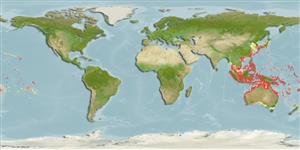Common names from other countries
Environment: milieu / climate zone / depth range / distribution range
Sinh thái học
Biển Cùng sống ở rạn san hô; Mức độ sâu 2 - 55 m (Ref. 30874). Tropical; 22°C - 28°C; 43°N - 40°S, 95°E - 130°W (Ref. 55292)
Pacific Ocean: Cocos-Keeling Islands and Western Australia (Ref. 27362) in the eastern Indian Ocean to the Marquesas and Oeno (Pitcairn group), north to southern Japan and southern Korea, south to Lord Howe Island, northern New Zealand, and the Austral Islands. Replaced by the very similar Pterois miles from the Red Sea to Sumatra.
Length at first maturity / Bộ gần gũi / Khối lượng (Trọng lượng) / Age
Maturity: Lm ?, range 16 - ? cm
Max length : 45.7 cm TL con đực/không giới tính; (Ref. 118189); Khối lượng cực đại được công bố: 1.4 kg (Ref. 118189); Tuổi cực đại được báo cáo: 10 các năm (Ref. 72479)
Các tia vây lưng cứng (tổng cộng) : 13; Các vây lưng mềm (tổng cộng) : 9 - 12; Tia cứng vây hậu môn: 3; Tia mềm vây hậu môn: 6 - 8. Scales cycloid (Ref. 37816). Variable in color, usually in relation to habitat. Coastal species generally darker, sometimes almost black in estuaries. Often with large tentacles above eyes (Ref. 48635).
Inhabit lagoon and seaward reefs from turbid inshore areas to depths of 50 m. Often solitary, they hide in unexposed places at daytime often with head down and practically immobile. Pelagic juveniles expatriate over great distances and the reason for their broad geographical range (Ref. 48635). Hunt small fishes, shrimps, and crabs at night, using its widespread pectorals trapping prey into a corner, stunning it and then swallowing it in one sweep. Dorsal spines are venomous; the sting can be treated by heating the afflicted part and application of corticoids (Ref. 5503). A popular table fish.
Life cycle and mating behavior
Maturities | Sự tái sinh sản | Spawnings | Egg(s) | Fecundities | Ấu trùng
Myers, R.F., 1991. Micronesian reef fishes. Second Ed. Coral Graphics, Barrigada, Guam. 298 p. (Ref. 1602)
IUCN Red List Status (Ref. 130435)
CITES (Ref. 128078)
Not Evaluated
Human uses
Các nghề cá: Tính thương mại; Bể nuôi cá: Tính thương mại
Các công cụ
Special reports
Download XML
Các nguồn internet
Estimates based on models
Preferred temperature (Ref.
115969): 22.4 - 29, mean 27.9 (based on 756 cells).
Phylogenetic diversity index (Ref.
82804): PD
50 = 0.5005 [Uniqueness, from 0.5 = low to 2.0 = high].
Bayesian length-weight: a=0.00813 (0.00632 - 0.01046), b=3.08 (3.01 - 3.15), in cm Total Length, based on LWR estimates for this species (Ref.
93245).
Mức dinh dưỡng (Ref.
69278): 4.4 ±0.4 se; based on diet studies.
Thích nghi nhanh (Ref.
120179): Chiêù cao, thời gian nhân đôi của chủng quần tối thiểu là dưới 15 tháng (Preliminary K or Fecundity.).
Fishing Vulnerability (Ref.
59153): Low to moderate vulnerability (34 of 100).
